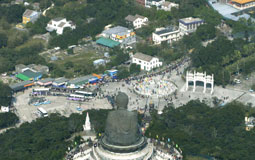 |
Big Buddha's big draw: A cable car linking Ngong Ping with Tung Chung will likely draw many more visitors to the site of the world's largest sitting Buddha. Infrastructure is being upgraded to meet the increased needs. |

|
An infrastructure project aimed at introducing sewage treatment works to the Ngong Ping tourist area is to be upgraded to support the higher number of visitors expected upon completion of the cable car linking it to Tung Chung.
The Government proposed upgrading part of the "Outlying Islands sewerage, stage 1 phase 1 part 1- Ngong Ping sewerage, sewage treatment and disposal" project to Category A for implementation of the Ngong Ping sewerage scheme.
The project, at an estimated cost of $250.4 million, would create about 150 new jobs, including 25 professional/technical staff and 125 labourers, during its construction period.
Across-the-board support
Members of the Legislative Council's Panel on Environmental Affairs heard this morning that the Bureau, the Islands District Council and the Tai O Rural Committee supported the proposed works.
The Bureau estimated the annual recurrent expenditure arising from this project to be about $5.3 million. The proposed works themselves would lead to an increase in the recurrent cost of providing sewage services by about 0.36%.
The Government plans to start construction of the proposed sewerage scheme, including public sewers and the effluent export pipeline, in August for completion in July 2005. This will enable it to be ready ahead of August 2005, the target commissioning date for the Cable Car System.
The project would include:
* laying about 0.65 kilometres of trunk and branch sewers in Ngong Ping;
* the construction of the Ngong Ping Sewage Treatment Works, including associated electrical and mechanical equipment and installations; and
* laying about 5.7 km of effluent-export pipeline from the treatment works centre to Tung Wan.
The MTRC will be entrusted to handle the pipe-laying works within the works boundary of its cable-car project to minimise public inconvenience arising from road openings.
The Administration will hire its own consultants and contractor to complete the rest of the project in the usual manner.
Cable car to boost visitors - and demand
The Environmental Protection Department completed a review of the Ngong Ping sewerage scheme in 2001, following theAdministration's decision to develop a cable car linking Ngong Ping and Tung Chung for tourism promotion.
The review concluded that the scheme should be expanded to cater for around 47,000 visitors and the related developments.
At present, there are neither public sewers nor sewage-treatment works at Ngong Ping. Its sewage is either shipped out by tankers or disposed of through privately owned septic tank and soakaway systems.
The sewerage scheme had originally been planned to cater for about 12,000 visitors a day and 500 residents in Ngong Ping.
Environmental impact minimal
Meanwhile, the authorities have completed Environmental Impact Assessment studies for the proposed works.
In general, the studies concluded that all the proposed construction works will not give rise to insurmountable environmental impacts with the implementation of mitigation measures.
During construction, the Government will control noise, dust and site run-off within established standards and guidelines by taking environmental mitigation measures.
They include temporary noise barriers and silenced construction plants to reduce noise, and water-spraying to reduce dust emissions.
The estimated cost of implementing these measures is $4.5 million, which has been included in the project estimate.
The Bureau has given due consideration to the need to minimise the generation of construction and demolition materials in designing the levels and layout of the sewage treatment plant and the levels and alignments of the proposed pipeline.
Contractors will be encouraged to use steel instead of timber in formwork and temporary works.
The project will generate about 82,000 cubic metres of construction and demolition materials. About 28% of it will be reused on site, 71% will be reused as fill in public filling areas and 1% will be disposed of at landfills.
The Environment, Works & Transport Bureau is hoping to table the proposal for consideration by the Public Works Subcommittee in April with a view to seeking the funding approval of Finance Committee in May.
Go To Top
|



